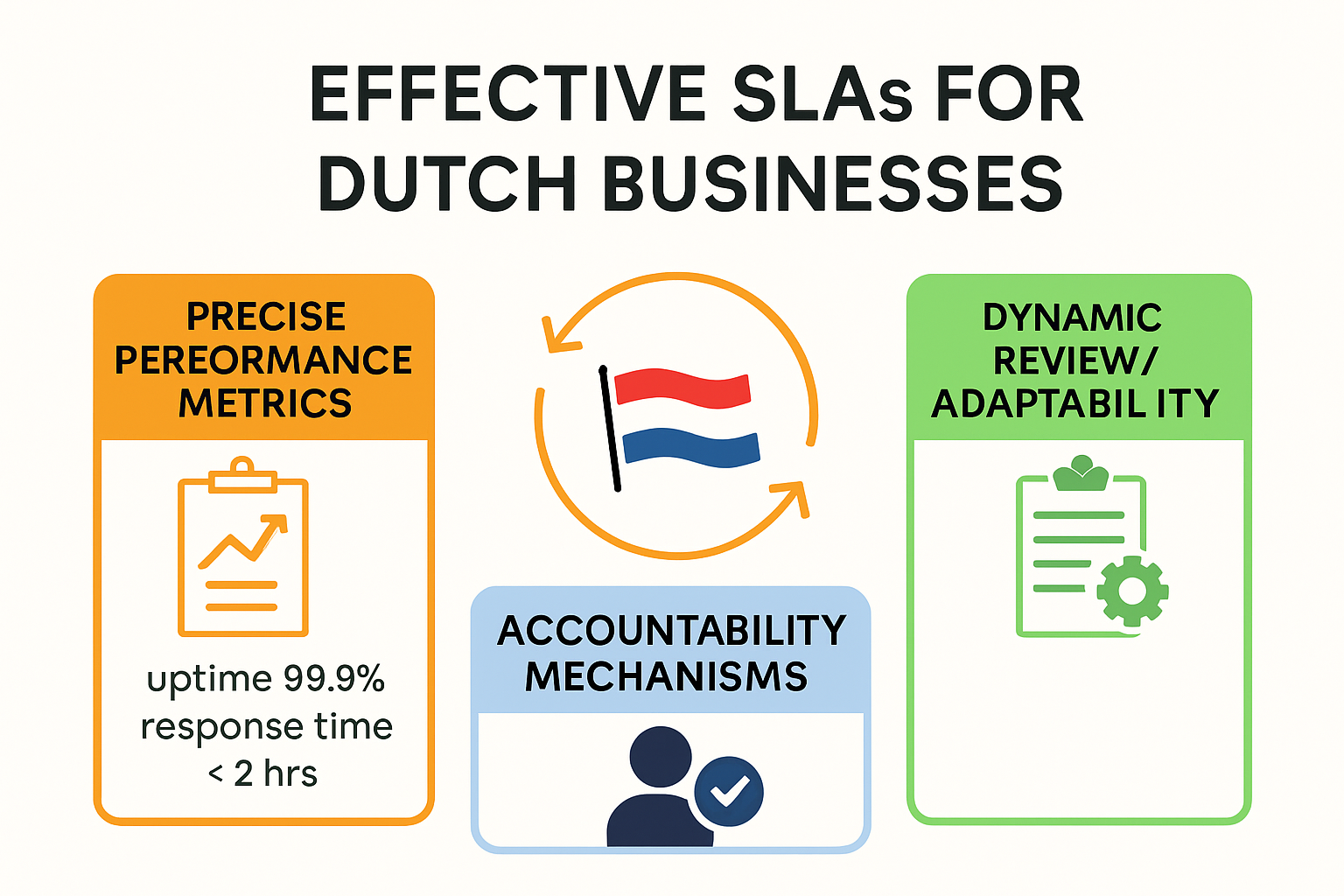Service Level Agreements are turning into the backbone of business reliability across the Netherlands. And yet with so much focus on cutting-edge tech and rapid digital transformation lately, many overlook a much older but critical detail. In the coming year, more than 70% of Dutch organisations will rely on SLAs as legally binding safeguards against service failures, but the greatest value often lies in how these agreements adapt to risk and change, not just how they define performance from day one.
Table of Contents
- Understanding SLAs: Purpose And Legal Relevance
- Key Elements Of Effective SLAs For Dutch Businesses
- Ensuring Compliance And Avoiding Common Pitfalls
- Best Practices For Negotiating SLAs In 2025
Quick Summary
| Takeaway | Explanation |
| SLAs Define Performance Expectations | Clear performance metrics in SLAs help manage service expectations and accountability. |
| Accountability Mechanisms Are Crucial | Robust accountability frameworks ensure consequences for failing to meet standards, enhancing service reliability. |
| Continuous Review Is Essential | Regular reviews of SLAs facilitate adaptation to changing business needs and technological advancements. |
| Proactive Risk Management Strategies | Identify compliance vulnerabilities and develop plans to mitigate risks before they escalate. |
| Holistic Negotiation Approaches Enhance Success | Comprehensive preparation and analysis lead to effective SLA negotiations that benefit all parties involved. |
Understanding SLAs: Purpose and Legal Relevance
Service Level Agreements (SLAs) represent critical legal instruments that establish clear performance expectations and accountability mechanisms between service providers and their clients. These comprehensive documents go far beyond simple contractual formalities, serving as fundamental frameworks that define operational standards, responsibilities, and potential remedies in professional service relationships.
The Core Legal Framework of SLAs
At their essence, SLAs function as precise legal contracts that articulate specific performance metrics, response times, quality standards, and resolution protocols. In the Netherlands, these agreements are particularly significant because they provide a structured approach to managing service expectations while offering robust legal protections for both parties. The legal relevance of SLAs stems from their ability to transform abstract service promises into measurable, enforceable commitments.
The Dutch legal system recognizes SLAs as binding contractual documents that can be instrumental in resolving disputes. When properly constructed, these agreements create clear benchmarks for performance, allowing organizations to hold service providers accountable through well-defined mechanisms. This approach prevents ambiguity and reduces potential conflicts by establishing transparent expectations from the outset.
Performance Metrics and Legal Implications
Performance metrics within SLAs are not merely administrative checklists but legally significant indicators of service quality. These metrics typically include quantifiable parameters such as uptime percentages, response times, resolution speeds, and specific service delivery standards. In the Netherlands, courts increasingly consider these predefined metrics when evaluating potential breach of contract claims.
For businesses operating in complex technological and service-oriented environments, SLAs provide critical legal safeguards. They establish precise standards that can be objectively measured and legally enforced. When a service provider fails to meet the agreed-upon metrics, the SLA provides a clear pathway for potential compensation, contract termination, or legal recourse. Learn more about contractual protections that complement SLA frameworks in the Dutch legal context.
Compliance and Risk Management
Beyond their immediate contractual function, SLAs play a crucial role in organizational risk management. They represent proactive legal instruments that help businesses mitigate potential service disruptions and establish clear accountability mechanisms. By defining explicit performance expectations, organizations can systematically assess and manage potential risks associated with service delivery.
In the rapidly evolving Dutch business ecosystem, SLAs have become essential tools for maintaining operational reliability. They provide a structured approach to managing service relationships, offering both parties clear guidelines and legal protections. The comprehensive nature of these agreements reflects the sophisticated approach to commercial interactions in the Netherlands, where precision, transparency, and mutual accountability are highly valued.
Whether implemented in technology, healthcare, finance, or other complex service sectors, Service Level Agreements represent more than contractual formalities. They are strategic legal instruments that balance operational efficiency with robust protective mechanisms, ensuring that service expectations are not just understood but legally guaranteed.
Key Elements of Effective SLAs for Dutch Businesses
Crafting robust Service Level Agreements (SLAs) requires meticulous attention to detail and a comprehensive understanding of organizational needs and legal frameworks. For Dutch businesses, these agreements represent sophisticated tools that balance operational efficiency with clear performance expectations and legal protections.
Precision in Performance Metrics
Dutch businesses recognize that effective SLAs demand precise, measurable performance metrics that go beyond generic statements. These metrics must be specific, quantifiable, and directly aligned with organizational objectives. Typical performance indicators include response times, resolution speeds, system availability percentages, and quality benchmarks.
The most effective SLAs transform abstract service promises into concrete, measurable commitments. This approach allows businesses to establish clear performance expectations that can be objectively evaluated. Metrics should be granular enough to provide meaningful insights yet comprehensive enough to capture the full spectrum of service delivery requirements.
Comprehensive Accountability Mechanisms
Accountability forms the cornerstone of effective SLAs in the Dutch business environment. These agreements must outline explicit consequences for failing to meet predefined performance standards. Robust SLAs include detailed escalation procedures, compensation frameworks, and potential remediation strategies when service levels fall below agreed benchmarks.
Businesses must develop nuanced accountability mechanisms that balance punitive measures with constructive problem-solving approaches. This might include financial penalties, service credits, or defined pathways for contract adjustment.
Adaptive and Dynamic Review Processes
The rapidly evolving technological and business landscapes demand SLAs that are inherently flexible and adaptable. Effective agreements include structured review mechanisms that allow periodic reassessment of performance metrics, technological capabilities, and changing business requirements.
Successful Dutch businesses implement dynamic SLA frameworks that incorporate regular performance reviews, technological updates, and mechanisms for continuous improvement. These review processes ensure that service level agreements remain relevant, responsive, and aligned with organizational strategic objectives.
The most sophisticated SLAs transcend traditional contractual boundaries, functioning as strategic tools for operational excellence. They represent collaborative frameworks that foster transparency, mutual understanding, and shared commitment to delivering exceptional service quality.
In the context of the Netherlands professional ecosystem, SLAs are not merely administrative documents but sophisticated instruments of business strategy. They reflect a mature approach to service delivery that prioritizes clear communication, measurable performance, and mutual accountability.
To help Dutch businesses clearly understand the critical components of effective SLAs, the following table summarises the key elements and their main purposes as discussed in this section.
| Key Element | Main Purpose |
| Precision in Performance Metrics | Define clear, measurable service expectations |
| Accountability Mechanisms | Establish consequences for not meeting standards |
| Adaptive Review Processes | Enable regular updates to align with changing needs |
| Granular Metrics | Provide detailed, actionable performance insights |
| Balanced Penalties and Remedies | Encourage improvement while protecting both parties’ interests |

Understanding and implementing these key elements enables Dutch businesses to create SLAs that are not just legally sound but strategically powerful. By focusing on precision, accountability, and adaptability, organizations can transform service level agreements from passive contracts into dynamic tools for continuous improvement and operational success.
Ensuring Compliance and Avoiding Common Pitfalls
Navigating the complex terrain of Service Level Agreements (SLAs) requires strategic foresight and a comprehensive understanding of potential compliance challenges. For Dutch businesses, proactively identifying and mitigating risks is fundamental to maintaining robust service delivery frameworks and legal integrity.
Identifying Potential Compliance Vulnerabilities
Successful SLA management begins with a thorough assessment of potential compliance vulnerabilities. Organizations must conduct comprehensive risk analyses that examine potential gaps in service definitions, performance metrics, and legal interpretations. These assessments should systematically evaluate potential areas of ambiguity that could lead to disputes or operational inefficiencies.
Critical vulnerability areas often include imprecise performance measurements, inadequate dispute resolution mechanisms, and unclear escalation protocols. Dutch businesses must develop sophisticated screening processes that identify these potential weaknesses before they become problematic. This approach requires a multidisciplinary perspective that combines legal expertise, operational knowledge, and strategic planning.
The following table organises typical compliance vulnerabilities found in SLAs and the mitigation strategies outlined in the article. This serves as a quick reference for businesses aiming to strengthen SLA compliance in the Netherlands.
| Compliance Vulnerability | Example / Challenge | Mitigation Strategy |
| Imprecise Performance Measurements | Ambiguous or vague metrics | Use specific, quantifiable criteria |
| Inadequate Dispute Resolution | Unclear escalation processes | Define detailed escalation and resolution steps |
| Unclear Escalation Protocols | Confusion over next actions when issues arise | Include step-by-step escalation procedures |
| Insufficient Monitoring | Lack of real-time oversight | Implement automated and human verification tools |
| Contractual Ambiguity | Legal interpretations open to dispute | Seek legal expertise for clarity and precision |
Implementing Robust Monitoring and Verification Mechanisms
Effective compliance in SLAs demands sophisticated monitoring and verification systems that provide real-time insights into service performance. Organizations need to establish comprehensive tracking mechanisms that can objectively measure and validate service delivery against predefined metrics. These systems should incorporate automated reporting, periodic audits, and transparent documentation processes.
The most successful approaches integrate technological solutions with rigorous human oversight. This might involve developing specialized software platforms that can track performance indicators, generate comprehensive reports, and flag potential compliance issues before they escalate. Explore strategic corporate compliance frameworks that can enhance your organization’s monitoring capabilities and legal protection.
Proactive Risk Mitigation Strategies
Risk mitigation in SLAs requires a forward-looking approach that anticipates potential challenges and develops strategic contingency plans. Dutch businesses must move beyond reactive compliance models and embrace proactive risk management strategies that can adapt to changing technological and regulatory landscapes.
Key risk mitigation strategies include developing flexible contract structures, implementing comprehensive training programs for stakeholders, and establishing clear communication channels for addressing potential issues. Organizations should create detailed contingency plans that outline specific actions to be taken in various potential scenarios, ensuring rapid and effective responses to service delivery challenges.
The Dutch business environment demands a nuanced approach to SLA compliance that balances legal precision with operational flexibility. Successful organizations recognize that compliance is not a static concept but a dynamic process requiring continuous refinement and adaptation.
Ultimately, effective SLA compliance transcends mere contractual adherence. It represents a strategic approach to service delivery that prioritizes transparency, mutual understanding, and continuous improvement. By developing sophisticated compliance frameworks, Dutch businesses can transform potential risks into opportunities for enhanced performance and stronger client relationships.
Businesses that master the art of SLA compliance position themselves as industry leaders, demonstrating a commitment to excellence that extends far beyond simple contractual obligations. The most successful organizations view compliance not as a burden but as a strategic advantage that differentiates them in an increasingly competitive global marketplace.

Best Practices for Negotiating SLAs in 2025
Navigating Service Level Agreement (SLA) negotiations in 2025 demands a sophisticated approach that balances technological innovation, legal precision, and strategic foresight. Dutch businesses must develop nuanced negotiation strategies that anticipate emerging challenges and create flexible, forward-looking service frameworks.
Strategic Preparation and Comprehensive Analysis
Successful SLA negotiations begin with meticulous preparation and a holistic understanding of organizational requirements. Businesses must conduct comprehensive internal assessments that map existing operational needs, technological capabilities, and future growth projections. This preparatory phase involves creating detailed service requirement specifications that go beyond surface-level performance metrics.
Effective negotiators develop robust benchmarking strategies that compare potential service offerings against industry standards, technological capabilities, and competitive landscapes. This approach requires cross-functional collaboration, bringing together perspectives from legal, technical, operational, and strategic departments to create a comprehensive negotiation framework.
Crafting Precise and Adaptive Performance Metrics
The cornerstone of effective SLA negotiations lies in developing precise, measurable, and adaptable performance metrics. In 2025, these metrics must transcend traditional quantitative measurements, incorporating qualitative indicators that reflect the complex nature of modern service delivery. Organizations should focus on creating metrics that are not just retrospective but predictive, offering insights into potential future performance challenges.
Negotiators must prioritize flexibility, building mechanisms for periodic review and adjustment of performance standards. This might include creating dynamic scaling mechanisms that can adapt to technological advancements, market changes, and organizational growth. Explore comprehensive business contract negotiation strategies that can enhance your organization’s contractual approach.
Establishing Robust Governance and Dispute Resolution Mechanisms
Modern SLA negotiations require sophisticated governance frameworks that establish clear accountability, communication protocols, and dispute resolution mechanisms. Successful agreements in 2025 will incorporate advanced technological and legal provisions that anticipate potential challenges and provide clear pathways for resolution.
Businesses should develop comprehensive escalation protocols that define precise steps for addressing performance issues, including detailed mechanisms for performance improvement, financial compensation, and potential contract adjustments. These governance structures must balance rigorous accountability with constructive problem-solving approaches.
The Dutch business environment demands a nuanced approach to SLA negotiations that reflects the country’s reputation for innovative, transparent, and collaborative business practices. Successful negotiations in 2025 will view SLAs not as static documents but as dynamic strategic instruments that facilitate ongoing partnership and continuous improvement.
Negotiators must approach SLA discussions with a holistic perspective that considers technological capabilities, legal frameworks, operational requirements, and future potential. The most effective agreements will create frameworks that are simultaneously precise and flexible, allowing for adaptation while maintaining clear performance expectations.
Ultimately, successful SLA negotiations in 2025 will require a sophisticated blend of technological understanding, legal expertise, strategic thinking, and collaborative spirit. Organizations that master this approach will transform service level agreements from mere contractual documents into powerful strategic tools that drive operational excellence and competitive advantage.
Frequently Asked Questions
What is a Service Level Agreement (SLA)?
A Service Level Agreement (SLA) is a formal document that defines the performance expectations and responsibilities of service providers and clients, serving as a legal framework to ensure accountability and reliability in service delivery.
Why are SLAs important for businesses in the Netherlands?
SLAs are crucial for Dutch businesses as they establish clear performance metrics, reduce potential conflicts, and provide legal protections, ensuring that service expectations are met consistently in a rapidly changing business environment.
What key elements should be included in an effective SLA?
An effective SLA should include precise performance metrics, comprehensive accountability mechanisms, adaptive review processes, and clear dispute resolution procedures to ensure transparency and mutual understanding between parties.
How do SLAs contribute to risk management in organisations?
SLAs play a significant role in risk management by outlining specific performance expectations and accountability, enabling businesses to proactively identify, assess and mitigate potential service disruptions and compliance vulnerabilities.
Ready to Strengthen Your SLAs for 2025?
You have seen how Service Level Agreements set the foundation for reliability, measurable performance, and legal clarity in the Dutch market. Yet many organisations face anxiety around compliance gaps, unclear dispute solutions, or ever-shifting service requirements. The risks of vague performance indicators or one-sided escalation clauses can quickly turn certainty into costly disputes. Your peace of mind should not rest on uncertain terms. At Law & More, our experienced legal team crafts and reviews SLAs that stand up to scrutiny, reflecting your unique operational needs and legal protections—covering everything from precision-driven metrics to proactive risk management.
Do not let hidden vulnerabilities or missed compliance trips undermine your business goals. Connect with Law & More’s SLA specialists for a tailored assessment. Secure agreements that truly protect your interests and foster long-term business success. Start your journey by requesting a consultation directly on our platform.
